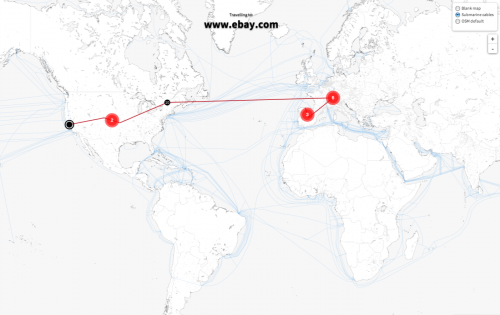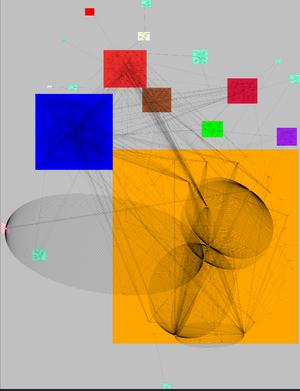User:Roelroscama/gradreserach: Difference between revisions
Roelroscama (talk | contribs) No edit summary |
Roelroscama (talk | contribs) |
||
| (29 intermediate revisions by the same user not shown) | |||
| Line 1: | Line 1: | ||
== Tentative Title == | == Tentative Title == | ||
== Introduction== | |||
In 2013 classified documents proving extensive surveillance over and through the internet by the US and UK spy agencies where leaked by Edward Snowden. While the perceived circumstances that allowed for this surveillance are as diverse as the 'solutions' proposed, I will explore one scenario related to the topologies and practices within networks themselves. | |||
As such I aim to design a speculative scenario about post-prism networking. Departing from the idea that in response to the Snowden leaks computer networks in the near future will take on a plurality of different shapes and sizes, often local and specialised in nature and highly informed by diy culture and techniques. Locality and the ability to do something by one's self will take precedence over speed and efficiency, when it comes to designing and using networks. People will navigate multiple networks during a day, next to the web as we know it now. | |||
This project will travel into the near future, 2019, and bring back examples and documentation of the equipment, ideas, experiences and social practices of various of such future networks. I will try to walk a thin line between science fact and science fiction to tell a story that is real and legible but also speculative and reflective. | |||
== Relation to previous practice == | == Relation to previous practice == | ||
During my first year at the PZI I became interested in the infrastructure of the internet. That year [[User:Roelroscama/trim1/protoyping |I began experimenting with Traceroute]] which lead me to producing maps and diagrams that explored how I connected to the internet. A particular interest came from GeoIP libraries that I used to connect the servers and websites I visited to countries and physical locations on the planet. With this in mind I applied to the summer sessions residency and I made [[User:Roelroscama/gradreserach#Border_Check | Border Check]] to further explore my interests this topic. | |||
The second year I started off by getting some more hands-on experience with linux networking. [http://pzwart3.wdka.hro.nl/wiki/Bibliotecha Bibliotecha ] was one of the projects that I worked on and informed me as to what is possible and in what ways. Especially the way one can create ad-hoc or disconnected networks cheaply nowadays I find intriguing. | |||
== Relation to a larger context == | |||
'''Artists/designers that work from a perspective of infrastructure:''' | |||
Melle Smets > de Snelweg Safari, about vernacular highway culture. | |||
Trevor Paglen, on secretive infrastructures. | |||
Metahaven's design/image centric approach to infrastructure. | |||
'''Speculative design scenarios:''' | |||
Philip Ronnenberg > Post-Cyberwar series, imagines ways of communicating after the 'internet kill-switch' has been activated. | |||
Tuur van Balen > Pidgeon d'Or, modifying bacteria that live in the guts of pigeons to use them as soap-dispensing networks for cleaning cities. | |||
Mark Shepard > Sentient City Survival Kit, a speculative toolkit to deal with cities of the future that will be full of sensors. | |||
Danja Vasilliev > Netless, Imagines using public transport infrastructure as a way to send data through a network. | |||
== [[User:Roelroscama/gradproject#Practical_steps | Practical Steps so far]] == | |||
click | |||
== References == | |||
Alexander Galloway, ''Protocol'' | |||
Evgeny Morozov,''To Save Everything Click Here'' | |||
Tom Standage, ''Victorian Internet'' | |||
Victorian Internet | |||
Wendy Chun, ''Control and Freedom'' | |||
Gilles Deleuze, ''Postscript on the societies of control'' | |||
= Descriptions of previous work = | = Descriptions of previous work = | ||
=== Border Check === | === Border Check === | ||
[[File:BCv0.1-Screenshot.png |thumb| Screenshot of Border Check | 500px]] | |||
Border Check (BC) is a browser extension that maps how your data moves across the internet’s infrastructure while you surf the web. It will show you through which countries and networks you surf to illustrate the physical and political realities of the internet’s infrastructur using free software tools. | |||
[http://www.bordercheck.org www.bordercheck.org] | |||
{{#widget:YouTube|id=0_r-VBeDYyM}} | |||
=== Telewar === | === Telewar === | ||
| Line 67: | Line 67: | ||
http://www.the-force-of-freedom.com/telewar/images/upo3.png | http://www.the-force-of-freedom.com/telewar/images/upo3.png | ||
=== Traceroute maps === | |||
=== | [[User:Roelroscama/trim2/protoyping2#Traceroute_maps_II | Traceroutemaps of trimester II]] | ||
[[File:1_week_browsing.png |thumb| One week of browsing, one of the first visualizations. ]] | |||
[[User:Roelroscama/trim1/protoyping | Traceroute maps of trimester 1]] | |||
Latest revision as of 11:58, 6 January 2014
Tentative Title
Introduction
In 2013 classified documents proving extensive surveillance over and through the internet by the US and UK spy agencies where leaked by Edward Snowden. While the perceived circumstances that allowed for this surveillance are as diverse as the 'solutions' proposed, I will explore one scenario related to the topologies and practices within networks themselves.
As such I aim to design a speculative scenario about post-prism networking. Departing from the idea that in response to the Snowden leaks computer networks in the near future will take on a plurality of different shapes and sizes, often local and specialised in nature and highly informed by diy culture and techniques. Locality and the ability to do something by one's self will take precedence over speed and efficiency, when it comes to designing and using networks. People will navigate multiple networks during a day, next to the web as we know it now.
This project will travel into the near future, 2019, and bring back examples and documentation of the equipment, ideas, experiences and social practices of various of such future networks. I will try to walk a thin line between science fact and science fiction to tell a story that is real and legible but also speculative and reflective.
Relation to previous practice
During my first year at the PZI I became interested in the infrastructure of the internet. That year I began experimenting with Traceroute which lead me to producing maps and diagrams that explored how I connected to the internet. A particular interest came from GeoIP libraries that I used to connect the servers and websites I visited to countries and physical locations on the planet. With this in mind I applied to the summer sessions residency and I made Border Check to further explore my interests this topic.
The second year I started off by getting some more hands-on experience with linux networking. Bibliotecha was one of the projects that I worked on and informed me as to what is possible and in what ways. Especially the way one can create ad-hoc or disconnected networks cheaply nowadays I find intriguing.
Relation to a larger context
Artists/designers that work from a perspective of infrastructure:
Melle Smets > de Snelweg Safari, about vernacular highway culture.
Trevor Paglen, on secretive infrastructures.
Metahaven's design/image centric approach to infrastructure.
Speculative design scenarios:
Philip Ronnenberg > Post-Cyberwar series, imagines ways of communicating after the 'internet kill-switch' has been activated.
Tuur van Balen > Pidgeon d'Or, modifying bacteria that live in the guts of pigeons to use them as soap-dispensing networks for cleaning cities.
Mark Shepard > Sentient City Survival Kit, a speculative toolkit to deal with cities of the future that will be full of sensors.
Danja Vasilliev > Netless, Imagines using public transport infrastructure as a way to send data through a network.
Practical Steps so far
click
References
Alexander Galloway, Protocol
Evgeny Morozov,To Save Everything Click Here
Tom Standage, Victorian Internet
Wendy Chun, Control and Freedom
Gilles Deleuze, Postscript on the societies of control
Descriptions of previous work
Border Check
Border Check (BC) is a browser extension that maps how your data moves across the internet’s infrastructure while you surf the web. It will show you through which countries and networks you surf to illustrate the physical and political realities of the internet’s infrastructur using free software tools.
Telewar
Telewar is a research project by The Force of Freedom and Dave Young on the topic of drone warfare. The project was initiated in november 2012 during a three week residency at Upominki in Rotterdam. The result of the residency was a self-published booklet containing an heavily illustrated essay. In it we try to make some sense of the drone warfare phenomenon by looking at how the users of military UAVs represent themselves both officially and unofficially. This is done by examining places, images or artifacts where an official and regulated narrative on drones intersects with with a more spontaneous and uncensored one. Examples include public facebook profiles of UAV squadrons, the online second hand market for drone-related insigna and offical documents conerning the topic.
The latest iteration of the project consists of two film loops. One is a taxonomy of UAV uniform patches. In this film a collection of patches is categorized and classified into four distinct topics, animals, flight hours, mythology and the earth as a grid. By making this taxonomy and studying the symbols for their connotation and their history the viewer gets a better insight in how UAV operators view themselves and the world. The second film is a lexicon of drone terminology. By juxtaposing military jargon with images it tries to scrutinize the pentagon euphemisms that are used to talk about UAVs and the Global War on Terror.



